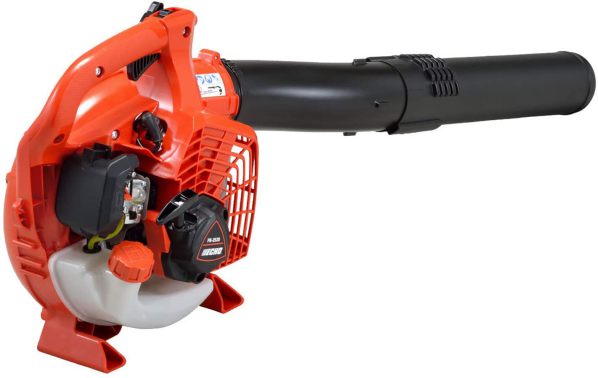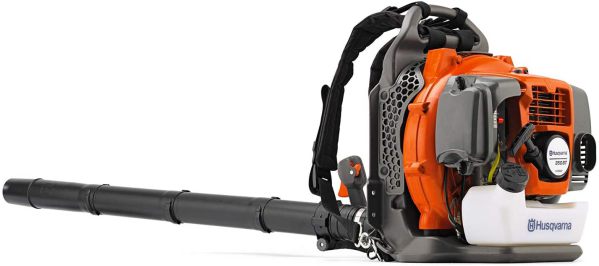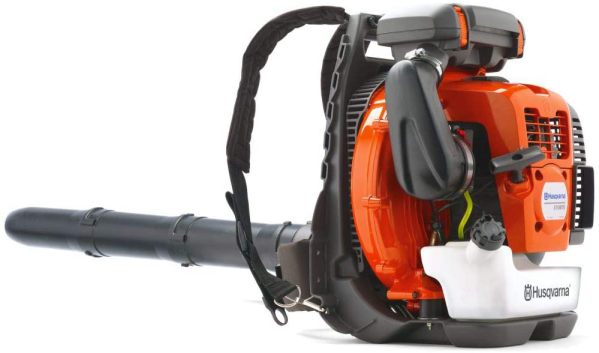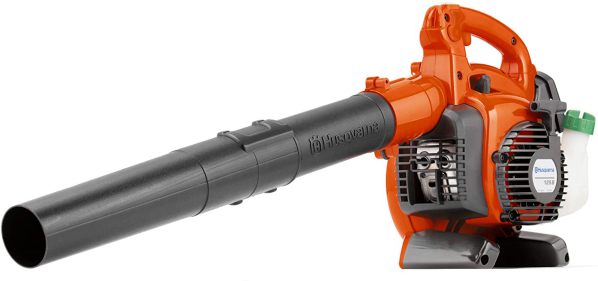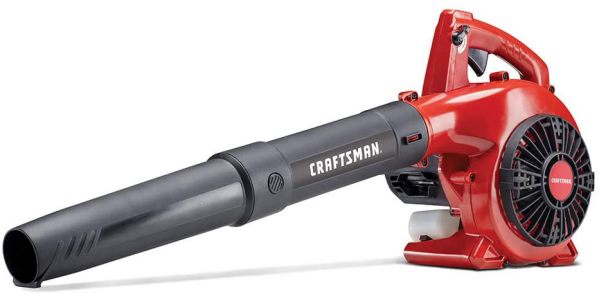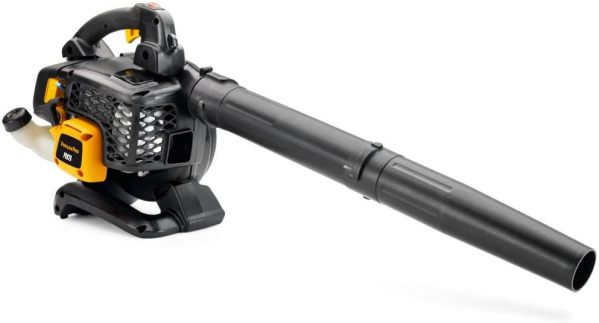The leaf blowers are the core sight in everyone’s garden; these are designed effectively to blow off the dead and dried leaves from your garden, back yard, porch area, and DriveSpace.
This leaf blower works with a high-power air force to complete the whole operation of cleaning your garden. They are the impulse to throw down all the debris and leaves within a short fraction of time.
There are different models of leaf blower striking in the market based on their working mechanism, including the electric leaf blower, cordless leaf blower, and the most convenient and traditional gas leaf blower.
These gas leaf blower models are a combination of productivity, affordability, and reliability. However, the task of finding the right fit keeping your requirements and budget in line can take forever. So, here’s the list of top-rated gas leaf blowers we reviewed and enlightenment of its buying guides to make you choose the best.
| ECHO PB-2520 (Best Handheld Blower)

|
| Husqvarna 350BT (Best Backpack Blower)

|
| Husqvarna 570BTS (Most Powerful Backpack Blower)

|
| Husqvarna 125B (Cheapest Handheld Blower)

|
| Craftsman B215

|
| Poulan Pro PRB26

|
This Post Contents
Best Gas Leaf Blower Reviews
1. ECHO PB-2520 25.4cc Handheld Gas Leaf Blower
The trendy and loved brand Echo is considered to have an exquisite taste of an exceptional service claiming perfect characteristics. We all have been familiar with its high technology and professional gear to make the product its requirement.
The brand launches this outstanding gas leaf blower model with the most accuracy and productivity. The robust and durable engine of the blower is undoubtedly powered by 25.4 cc, which is quite impressively high and mighty to deal with the most robust job standing.
The airflow rate from the engine measures the airspeed of the blower up to 170 miles per hour, and the air volume or density lies around 454 Cubic feet per minute.
The overall mechanism of the blower is handheld, leading to more convenient and desirable usage of the blower by its user through their hand involvement.
The operation timing of the blower is quicker than others, and no doubt it completes the task in no time. The infrastructure of the blower is noted to be very sharp and precise, which comes with the ultimate small weight of 1.52lbs, making the blower the most light-weighted gasoline leaf blower.
The Echo gives the product an advanced feature by providing flawless services in its four years of warranty.
Pros
- Easy setup and straightforward installing
- High-capacity power engine of 25.4 cc
- Comes except four years of warranty
- The lightweight nature of the blower makes it easy to portable.
Cons
- Comes little overprize and rare to find
- The issue, some significant level noise, might be harmful.
2. Husqvarna 350BT 2-Cycle Backpack Gas Leaf Blower
The gas leaf blower by the Husqvarna is a great fit if you’re looking for something home-based. This gas leaf blower has proven itself beneficial in many other ways with its plethora of outstanding outcomes.
The blower design comes backpack oriented making the usage easy yet convenient without the involvement of your hand.
The two-cycle gas backpack infrastructure is very sharp and attractive, with the entire weight around 22.5 pounds slightly heavy. Still, the operation became more convenient because of its back-wearing technique.
The X-torque engine of the blower has a 50.2cc power destined to reduce the retaining toxic gas while operating and enhances the fuel efficiency. The infrastructure of the blower includes an offset handle maintaining the lifting and running of the blower.
Due to the solid and powerful engine, the airflow generated for the blowing measure around 692.17 cubic feet per minute and the airspeed lies around 7500 RPM, which is 98.365 Miles per hour.
The blower comes with an ergonomic harness system and variable speed control to easily adjust Speed while the blower is in motion.
The additional feature of the blower is that it comes with a low vibe technology and the lowest frequency of 104 DBA for minimal noise while working.
Pros
- Highest CRM rating measures around 692 CFM
- Comes with an offset handle for easy carrying
- Backpack designing to relieve hand while using the machine
- X Torf engine inbuilt for reducing toxic emission and enhance fuel efficiency
- The price is not much higher compared to another blower.
- Two-year warranty from the brand.
Cons
- The airspeed of the blower isn’t impressive and lies around 180 mph
- Doesn’t involve any advanced upgrade feature
3. Husqvarna 570BTS Backpack Gas-powered Blower
Another exception from the Husqvarna manufacturer was designed and launched with exquisite properties and a spectacular functional lead to cut short all the extra effort and work you put in while cleaning up your lawn. The external and internal design is circulated for better-quality services.
The blower design includes an effective air purge for the quick and smooth starting of the blower with the commercial-grade air filter and a splendid fan for increasing the blowing capacity.
The overall weight of the blower somewhere lies between 24.7 lbs. The blower consumed an extremely robust power through its two-stroke engine, which ranges between 63cc to 66cc.
The feature of the blower also mentions an X-Torq engine technology that helps reduce toxic and harmful emissions and enhance fuel efficiency.
The backpack-themed, ergonomically designed blower comes with adjustable handles and is found beneficial for easy lifting and carrying while operating.
The airflow rate consists of around 236.2 Miles per hour, and the airflow density varies between 768 to 972 CFM. The operation of the blower also held quiet because of its minimum sound pressure of 76 dB, including a LowVib for low vibration monitoring.
Pros
- A durable and robust engine for better power and force
- Quick Speed of 236.2 miles per hour and density up to 972 CFM.
- Comes with additional features like an X-Torq engine and LowVib for better usage
- Backpack style and light-weighted character make the easy blower portable.
Cons
- Installing and assembling takes extra effort and timing.
- Doesn’t include any OEM vacuum kit.
4. Husqvarna 125B 28cc Handheld Gas Leaf Blower
So there is not a single hesitation or certainty about the quality service provided by the Husqvarna manufacturers. Another excellent addition of the gas leaf blower added to its glorious treasury for winning people’s hearts with its masterful assistance.
Husqvarna 125B is designed as two cycled blowers with the other sharp features attached in the physical composing like air purge for removing the air from the carburetor hence giving the blower a healthy and quick start. The hold of the power and nozzle is designed to handle the easy and simple job effectively.
The overall weight of the blower is around 9.4 lbs. Making the blower super portable and storing maintenance also get smoothly in line. The airflow rate includes the volume and speed measures to 425 cubics per minute and 170 Miles per hour.
Also, the blower consists of intuitive control and cruise control for adjusting the Speed of the air.
However, a distinct and prominent feature in the blower is the auto return and stop switch, which sharply switches the whole system to a guided reset for another start.
The product also didn’t harm the neighbors and users by its loud noises because of the 112 dba sound pressure mentioned but measured around the 94 dba, and the vibration doesn’t come in the way of operation.
Pros
- The additional benefit of intuitive control for straightforward usage.
- The airflow speed can be control by the cruise control
- The blowing tube length can be adjusted for better reach.
- Easy to assemble and simple monitoring
Cons
- Do not make its way for the more challenging job
- The fuel tank capacity is not much higher, lying around 16.91 fl oz.
5. Craftsman B215 25cc Handheld Gas-Powered Leaf Blower
The gas-powered leaf blower designed and introduced by the Craftsman manufacturers is the most valuable and productive blower for your small or residential usage requirement, and that too in extremely low pricing.
The gasoline blower comes under $200 but did the job efficiently and smoothly compared to the other blower.
The overall weight of the blower is around 11 pounds making the lifting and hour of working stress-free and easy. However, do not expect lesser characteristics of the blower because of its low weight and lesser price.
The blower has a magnificently easy startup with only three primary perspectives- prime, choke and pull. The blower doesn’t fail to amaze with its superlative power of a two-cycle engine using the 25cc power, which is responsible for the throwing of a strong and concentrated amount of air to blow up the leaves or other debris from your garden.
We noticed the airflow volume provided by this blower measured around 430 CFM through the Speed of 200 Miles per hour, making the job more competent and productive.
This gas-powered blower also features an easy start and a crucial speed cruise control giving every reason to buy in the first place.
Pros
- Easy initiation with prime, choke and pull strategy
- Light-weighted and convenient for regular residential use
- Require less maintenance
- Translucent tank eliminates the empty fuel reminder worries
- Very less expensive and affordable to everyone.
Cons
- Not recommended for the heavy task
- Less productive for large ground and limited to debris and leaves blowing.
6. Poulan Pro PRB26 25cc Handheld Gas Leaf Blower
Buying the gas-powered leaf blower is not what you do every day, so if you have made up your mind for an exceptional leaf blower but, somewhere budget affects your shopping strategy.
You need to immediately check this incredibly low-budget yet big performance gas-powered leaf blower to add beauty and hygiene to your garden.
The blower was designed for handling easier and simple jobs effectively with the powerful attributes inbuilt along in it. The portability of the gas-powered model doesn’t come along as the problem because of its light-weighted body structure of around 11 pounds.
The backbone power engine of the blower includes the neutral 25cc power and has been operated as a two-stroke engine for enhanced performance.
The robust engine of the blower provides an airflow density of 470 cubic feet per minute through an airspeed of 200 miles per hour. The produced power is capable of dealing with heavy and stubborn fallen leaves in your yard.
The leaf blower comes in handheld orientation which is directly proportional to the better reach. The design includes a harmless and conveniently holding handle for easy lifting and moving of the blower while in motion.
Sound and vibration attributes of the blower have also been reduced to their minimum for better doing the job and less affecting people.
Pros
- The price of the blower is exceptionally low.
- Airflow under the pipe measures up to 470 CFM high enough for rigid leaves.
- Comes with the cylinder displacement properties
- User friendly and easy to monitor
- Slow sound and minimal vibrational mode.
Cons
- Not good enough for the heavy task.
- A handheld operational theme can leave your hand busy.
Gas leaf blower: A right option for your garden
Let’s consider the fact that who doesn’t like the fresh, amusing air coming right from your lively garden area. Those soft and soothing breezes from the trees in your yard and the revitalizing vibes from the surrounding can captivate any sour heart.
However, due to the change in the law of nature, your fresh garden area gets sooner covered with the orange and golden piles of leaves after the autumn fall and then the most challenging part comes.
Therefore, investing in a leaf blower can really be the most productive and competent by pouring the fresh and clean aura into your garden areas.
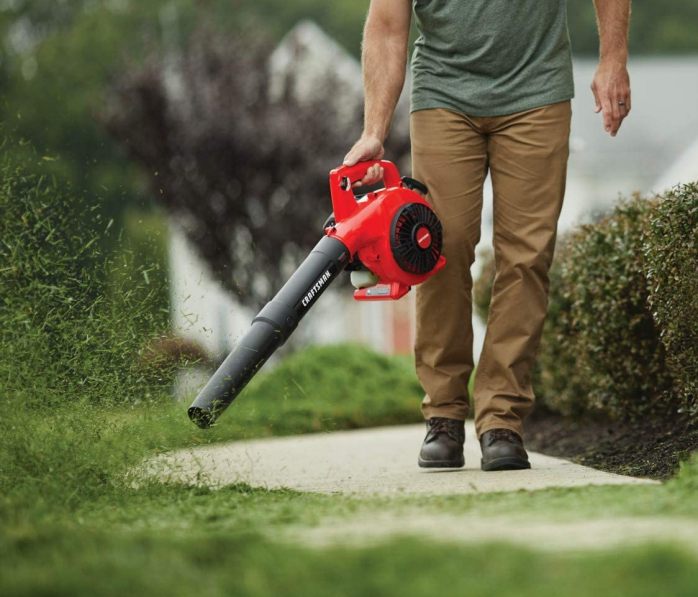
Basically, a leaf blower is a gardening tool designed for improvising the garden area by cleaning out every debris and dead leaves with the help of a specific infrastructure of a nozzle that pours a concentrated amount of air.
These leaf blowers are operated either with electricity or gasoline. The gas blower mechanism has either two-stroke or four-stroke engines and are found to be the most effective among each other.
The gas-powered leaf blower doesn’t limit blowing off the leaves alone; they have also been considered helpful in various other tasks such as removing dirt and garbage, dealing with soft snow, cleaning porches or sidewalks, or just drying things out.
They are bound to use gasoline or some kind of fuel operation, which is stored in the gas engine and monitored by sucking air from the inlet and thrown out at high Speed in a concentrated way to aim at specific piles of the leaf.
These gas-powered leaf blower models have been popular icons because of their convenient character; however, these blowers are named and classified into several categories according to their usage.
To be specific, these gas-powered models are usually of three types, Backpack, Handheld, and Walk-behind Blower.
Backpack Gas Leaf Blower– these blowers have been operated by carrying at the back; their designs are intended to be light weighted with the strap attached so that you can wear them like a bag for easy mobility.
Handheld Gas Leaf Blower– as its name, the handheld blower works by lifting or carrying, which might cost the engagement of your hands. However, they can be put down or lifted again at a real quick switch.
Walk-Behind Gas Leaf Blower– The walk-behind Gas Leaf blower is designed for extremely heavy tasks and spreads wide around because of its high durability and productivity. The infrastructure of the blower includes wheels for movement while in motion.
These all kinds of blowers are chosen according to their usage requirement; the backpack and handheld gas blower are devoted for small, residential use while the walk-behind leaf blowers are for heavy and large jobs.
Compared to the traditional and manual brooming, gas leaf works a lot quicker and conveniently by collecting the leaves at a specific spot away from your garden.
You need to be extra cautious while monitoring a gas leaf blower and do some prep-up before operating one. Make sure you have gone through all the manuals’ precise details, and check closely for any leakage or broken part before starting the blower.
Move the blower in a semi-circle pattern for better results. Always ensure that there is no obstacle or any materialistic things that come in the way of the blower, and to avoid any injury or accident, always take safety precautions.
Using the blower in an appropriate way, the result can be really promising and productive.
Why gas-powered leaf blower is better than an electric one?
After the incredible services and outcome of the blowers, the question arises: What makes the gas leaf blower more beneficial than the electric blower?
As you can see, the electric leaf blower often comes in handy and has been more popular among the crowd because of its light-weighted and cheap properties.
However, if we are talking about more improved and exceptional results even in the large ground, the gas-powered model came at first sight.
There are various valid facts that point out that gasoline blowers are more competent than electrical blowers in several ways.
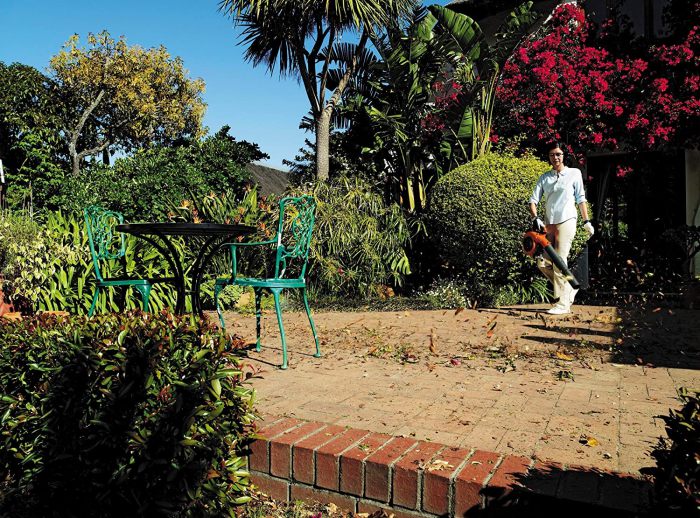
Operation base
The operation of both models of leaf blower is the same, that is to move the debris like leaves, dirt, snow through propelling the air in a concentrated way. However, the gasoline blower requires regular gas or fuel, while the electrical blower will require a lot of power to operate. The involvement of electricity also makes the blower usage dangerous.
Power
The gas-powered model always wins hearts when we consider the result or outcome. The electric model might be convenient to use but terribly failed to do high duties and work on a large ground basis. At the same time, the gasoline models are designed for performing large jobs on the commercial or huge ground with strong durability access.
Infrastructure
Considering that the infrastructure also affects the blower’s overall performance, we must discuss how the gasoline blower is more comforting and convenient in comparison to the electric one. The gasoline blower comes in the backpack, handheld and wheel behind the model, which gives the user a simple and straightforward use as per the user requirement.
Purpose
The gasoline leaf blower is found more productive and effective than any other blower. Due to its high durability and strong power, the gas-powered blowers are not limited to single-use; they can be operated for various purposes other than blowing leaves, they can be useful for tasks like cleaning patios, throwing other garbage, dealing with the soft snow, and flushing your sidewalk and porches area.
Cost
The cost of the gas leaf blower can be slightly higher than the electric blower; however, there is such a single doubt in saying that the gasoline blower can be termed as a one-time investment. The electric leaf blower might cost little, but they are not supposed to last longer, which is the opposite of the gas-powered blower.
Air force
The air force range varies differently for gas and electric leaf blowers; remember, the high air force always improves productivity. The air force for the gas-powered blower is around 150+ MPH, and the electric blower ranges from around 50- 100 MPH.
Some crucial don’t for a gas-powered leaf blower user.
There is no other saying that the gas-powered leaf blower is straightforward to use; however, there are some tips and tricks involved to make the result more effective.
If you own a gasoline blower, there are some crucial points enlisted below, which you should avoid while working with the gas-powered model to improve your regular blowing operation.
- Do not go blowing without reading the entire instruction.
- Do not intend to wear loose clothes or other attire
- Do not let your kids surround the whole blowing operation
- Do not focus the tipping air on any animal or person to avoid any harm
- Do not go without earbuds or any ear protection while blowing
- Do not operate the blower through the ladder or by standing over the tree
- Do not mix up the blowing technique; always work in a semi-circle pattern.
- Do not overuse the air filter and change the filter frequently.
- Do not leave your blower without any maintenance for a long time.
Important consideration aspect for buying the gas leaf blower
The gas-powered blower generates extremely high power than a then corded or cordless electric blower, which makes the task of blowing quicker and convenient with the promising outcome.
As a buyer, you need to take some serious consideration for investing in a high-performance leaf blower that can really be with you for a long period.
For Improving your selection procedure and saving your money as well, we have compelled some crucial factors one should look at before buying one gas leaf blower.
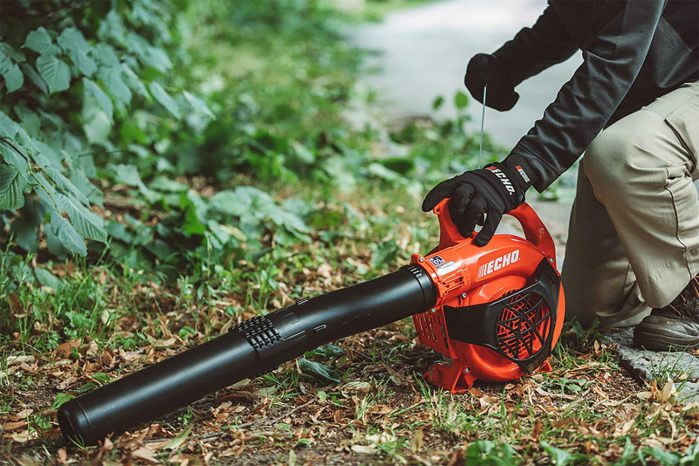
Engine
The very first point to look at while buying the gas leaf blower is the engine power; the gasoline blower comes either being two-stroke or four-stroke engines. The choice of the engine can differ on the basis of your requirement. The two-stroke engine blower is most commonly in use, while the four-stroke engine is bulky and heavy but powerful and can be very efficient when it comes to high duties.
Nozzle
The blower’s nozzle is the most crucial part of examining; the nozzle is the key operation point of the blower. These blowers are designed to throw out the air for blowing the leaves. Thus, it would be best if you noticed the shape and structure of the blower’s nozzle, specifically rounded or flat, according to your need.
Airflow Rate
While considering buying the gasoline leaf blower, you need to be sure of the airflow rate of the blower. This airflow range is directly connected to the power and outcome of the blower. This airflow rate includes the airspeed and the airflow density. The airspeed of the blower is measured in the MPH, Miles Per Hour, and the air volume or density is measured in CFM, Cubic Feet Per Minute. Choose the airflow rate as your usage requirement.
Weight
The weight of the blower depends on the blower you choose; the backpack or a handheld gasoline leaf blower is light weighted and easy to carry, while the wheel-behind leaf blower is bulky and heavy weighted. Therefore, if you are looking for something for high portability, you must consider a light-weighted blower.
Air intake and Speed
Some of the blowers suck the air in order to reflect it in a concentrated way through the nozzle for blowing off the leaves. You need to check the mechanism of air take and its capacity for a more convenient job. Check the Speed of the blower while doing the job. Also, check whether it has any speed adjustment involved with the blower.
Gas or fuel type and capacity
If we are talking about the gasoline leaf blower, the fuel or gas is the principal point to analysis. The gas or fuel directly affects the outcome and operation of the blower. These are some of the few points you need to check under the fuel category for a better purchase.
- Check the type of fuel or gas compatible with your purchased leaf blower. Check whether it is common and can be easily available in the market.
- Make sure the fuel or gas convenient for your blower isn’t very expensive.
- Check the infrastructure of the gas tank and its durability.
- Make sure the gas or fuel tank capacity is enough to give you stress-free blowing rounds.
- Check whether the gas tank design is translucent or not to allow easy access to notice while your tank gets empty.
Category of the blower
The various categories of gas leaf blower models revolve in our market; you need to pick one right fit for your garden. These categories may include backpack blower, handheld blower or the wheel behind. These all separate with their different usage tactics and upshot. If you are recruiting the blower for regular and residential usage, you should prefer a backpack or handheld blower, while if you are looking for a heavy task, go for the wheel behind the blower.
Noise
You might be aware that the Gas-powered blower is a bit louder than the electric blower; thus, the very next point you need to analyze is the noise characteristic of the blower. The noise is directly proportional to the power and the airflow. The higher the power of the engine, the higher the noise it will be. However, we recommend you consider a low noise blower.
Frequently asked questions
Q. What is the right pricing for a gas-powered leaf blower?
Typically, the gas-powered leaf blowers are found to be more expensive than the usual or electric ones. The cost of the gas-powered blower certainly lies around $250 to $500. However, the pricing may differ with its specification and features. But the common and genuine price to consider is $300 for resident and regular usage blower and $400 -$450 for high power gas blower.
Q. What is the differences between gas-powered and electric leaf blowers?
In terms, the gasoline and electric leaf blower work the same way, but they have been operated on gas or fuel or electricity respectively. These models differ not only with these functioning anchors but also the electric leaf blower is not found to be more productive as the gas-powered blower are, including doing the high duties task. And the gas-powered blowers are less portable than the other ones. So, they both bear a lot of differences between them.
Q. How to make the gas leaf blower stay longer?
For the effective using of gas leaf blower, you need to read the instruction on the manual and its care instruction carefully and works as accordingly, providing your gas leaf blower with the best and most compatible gas or fuel it requires, always changing its air filter frequently and always perform a little care service after the using of the gas leaf blower. Also, do not forget to give your blower relevant maintenance from time to time.
Q. What fuel should you use in a gas leaf blower?
First, you can go with any kind of regular fuel or gas, but do not check the fuel compatibility with your blower. Maximum of the blower uses regular unleaded gasoline-like octane gas or ethanol blend while some of them crave for the premium gasoline to operate and proclaim better results with the high performance. So you have to choose the gas according to your blower.
Q. Can we use a leaf blower to clear wet leaves?
The answer to the question is yes, but it varies on the blower’s durability and infrastructure and the kind of blower you are using. Usually, a gas leaf blower can easily help up with your snow clearing task; if the snow isn’t strong and frigid, the gas leaf blower is also designed to work for your wet leaves piles in the garden but with some power setting and controlling which might come mentioned in the manual.
